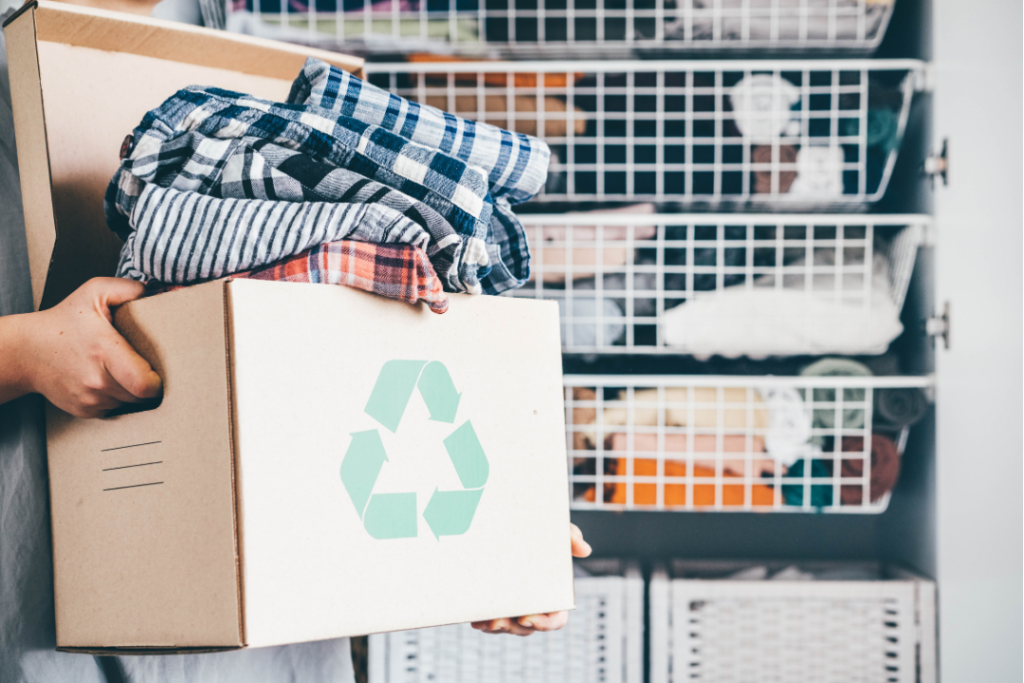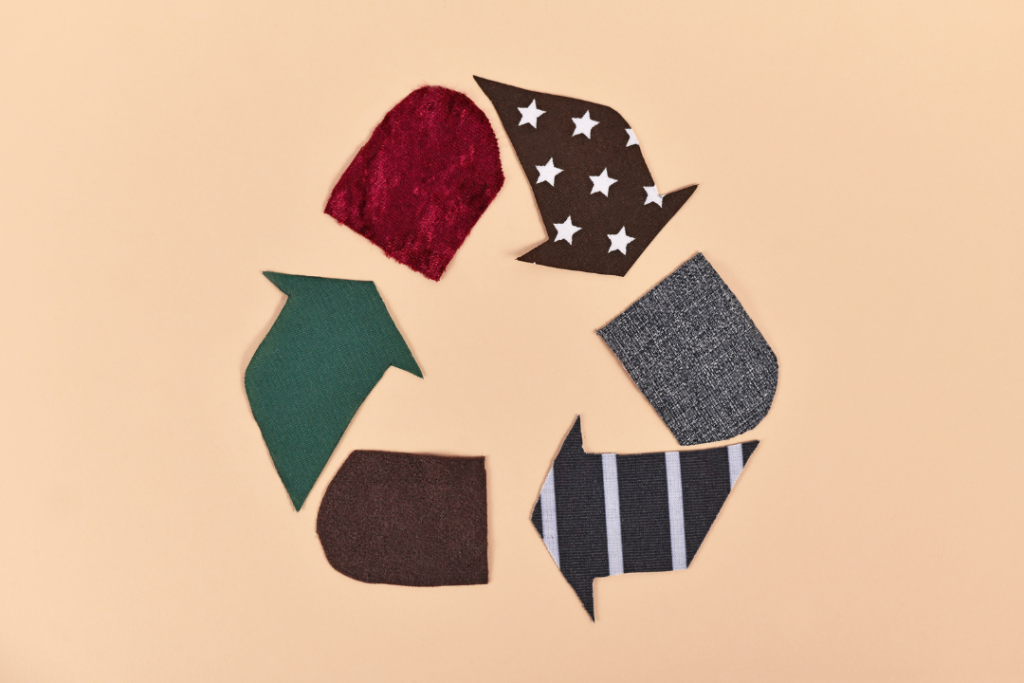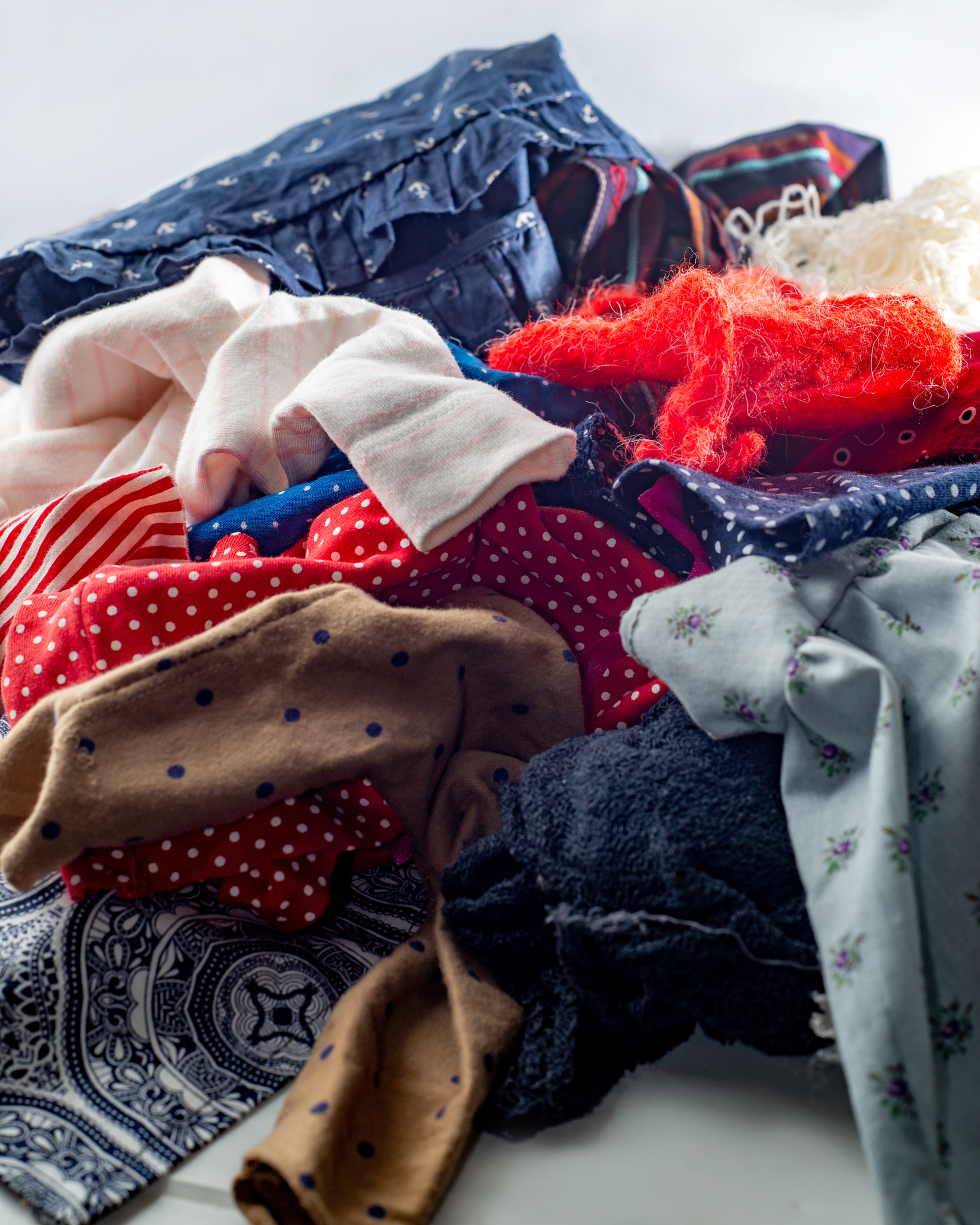Recycling old clothes is important for waste reduction and minimizing our environmental impact. This article will discuss the benefits of clothes recycling, effective recycling methods, and where to find recycling options.
Textile waste is a significant contributor to the waste stream, as millions of pounds of textiles are disposed of annually. Recycling old clothes not only diverts them from landfills but also conserves resources and reduces our carbon footprint. Moreover, recycling textiles can support various charitable organizations and secondhand markets, benefiting others with our unwanted items.
When it comes to recycling clothes, there are various options to consider. One popular choice is donating usable clothing to thrift stores or local charities, as this allows the items to find new owners who can continue using them. Additionally, textile recycling programs provide a solution for torn or unusable items, as they can be broken down and transformed into new materials or repurposed for different purposes.
Learn about different ways to recycle old clothes, including donation bins, textile recycling companies, and take-back programs for all types of items. Let’s contribute to a cleaner and more sustainable future.
Why Clothes Recycling Is Important

Textile recycling plays a crucial role in minimizing the environmental impact of clothing waste. The fashion industry is one of the largest contributors to landfill waste, with millions of tons of textiles discarded each year. By diverting textiles from landfills and recycling them, we can address this issue and reduce the harmful effects on our planet.
When textiles decompose in landfills, they release greenhouse gases such as methane, contributing to climate change. Furthermore, the production of new textiles requires significant amounts of energy, water, and resources. By recycling textiles, we can save these valuable resources and reduce pollution associated with textile production.
Additionally, textile recycling allows for the potential reuse and repurposing of clothing items. Usable clothing can be donated to thrift stores, providing a sustainable option for those in need. Torn or damaged textiles can be transformed into new materials, such as insulation or car seats, preventing them from becoming waste.
By embracing textile recycling, we not only reduce the amount of textile waste in landfills but also conserve resources and minimize the carbon footprint associated with clothing production. It’s essential to raise awareness about the importance of textile recycling and explore the various options available to ensure a sustainable and eco-friendly future.
How to start?

To ensure that your clothes are properly sorted and ready for recycling, follow these simple steps:
1. Empty your closet: Start by taking out all of the clothes from your closet and placing them on a clean, flat surface. This will allow you to clearly see and assess each item.
2. Sort through your clothes: Begin by examining each piece of clothing individually. Look for any stains, tears, or signs of excessive wear. Separate the clothes into different piles based on their condition.
3. Separate wearable clothes: Set aside the clothes that are still in good condition and can be worn by others. These items can be donated to local thrift stores or charitable organizations. To make the process easier for the charity, consider labeling the different types of clothing (e.g., shirts, pants, dresses) or grouping them by size.
4. Repurpose stained and torn items: For clothes that have stains or small tears, consider repurposing them as household wipe cloths or cleaning rags. Simply cut them into smaller pieces and use them for various cleaning tasks around the house. If the stains or tears are too large for repurposing, these items can be sent away for textile recycling.
5. Textile recycling: Look for textile recycling options in your area. Many recycling centers and organizations specialize in recycling old clothes and turning them into new materials. By recycling these items, you can prevent them from ending up in landfills and contribute to a more sustainable future.
9 Ways to Recycle Old Clothes
Recycling old clothes is a simple yet powerful way to contribute to a more sustainable future. Whether it’s through donations, upcycling, or repurposing, these nine methods offer various ways to minimize textile waste and make a positive impact on the environment:
1. DIY Dust Rags

If you have old clothes that you no longer wear or need, don’t throw them away just yet! Repurposing them into dust rags is a great way to give them a new life and reduce waste. Dust rags are handy for cleaning various surfaces around your home, and you can easily create them yourself.
When selecting old clothes for dust rags, look for materials that are absorbent and gentle on surfaces. Flannel is an excellent choice as it captures fine particles effectively. For delicate wooden surfaces, opt for soft, scrubbed poplin to ensure a polished finish.
To create dust rags, start by cutting the old clothes into appropriate sizes. You can cut larger pieces into smaller squares or rectangles that are easy to handle. It’s important to use fabric that would have otherwise been discarded, as this helps reduce textile waste and lessen the burden on landfills.
Once you have your pieces of fabric, simply use them as dedicated dust rags for different areas of your home. You can use them to dust furniture, wipe down surfaces, or even polish mirrors. When they become dirty, toss them in the laundry, and they’ll be ready to use again after washing.
Repurposing old clothes into dust rags is not only a sustainable choice but also a budget-friendly one. So, next time you have old clothes that you don’t use anymore, put them to good use as dust rags and contribute to a cleaner and greener home.
2. Home Made Pillows

If you have old silk blouses lying around that you no longer wear, why not repurpose them into luxurious silk pillows? Silk pillowcases are not only an elegant addition to your bedroom decor, but they also have several benefits for your hair and skin. They reduce friction, which helps prevent hair breakage and tangling, and they absorb less moisture compared to cotton, helping to keep your skin hydrated throughout the night.
To transform your silk blouses into pillows, you’ll need a sewing machine. If you don’t own one, consider borrowing a sewing machine from your local library. Many libraries have sewing machines available for public use, making it a cost-effective solution for your DIY project.
Start by carefully cutting out the desired pillow shape from the silk blouse. Cut two identical pieces for the front and back of the pillow. Place the two pieces together, with the right sides facing each other, and sew around the edges, leaving a small opening to insert stuffing. Once you’ve inserted the stuffing, sew the opening closed, and your silk pillow is complete.
Not only will repurposing old silk blouses into pillows give them a new life, but it’s also a sustainable way to reduce textile waste. So why not indulge in the luxury of silk pillowcases while also being environmentally conscious?
3. Dress Up Your Dolls

If you have old clothes that you no longer wear, instead of throwing them away, why not repurpose them into something new? One creative idea is to transform your old shirts into cute and stylish clothes for your dolls. Whether you have Barbie dolls or stuffed animals, this DIY project is a fun and sustainable way to give your dolls a fashionable makeover.
To repurpose your old shirts into doll dresses or smocks, start by selecting a shirt that you no longer wear or that no longer fits. You can choose a shirt with an interesting pattern or a solid color that you like. Lay the shirt flat on a table and carefully cut out the desired dress or smock shape.
If you want to add a belt to your doll’s dress, you can also cut out a strip of fabric from the shirt or use a small belt from your own collection. Simply cut the fabric to the desired length and sew it onto the dress.
Once you’ve cut out the dress and added any desired embellishments, stitch the sides and bottom edges together using a sewing machine or by hand. Pay attention to the measurements to ensure a snug fit for your dolls.
By repurposing your old shirts into doll clothes, you not only get to be creative but also reduce textile waste. Give your dolls a fashionable and sustainable wardrobe by repurposing your old clothes into stylish dresses and smocks.
4. Consider a Clothing Swap

A clothing swap is a fun and eco-friendly way to update your wardrobe without spending any money. It involves exchanging unwanted clothing items with friends, family, or even strangers. Here’s how you can organize a successful clothing swap:
1. Gather participants: Reach out to your friends, family, and colleagues and invite them to participate in the clothing swap. You can also advertise the event on social media platforms or local community groups to attract more people.
2. Set a date and location: Choose a convenient date and location for the clothing swap. It can be held at your home, a community center, or even a local park. Make sure to provide enough space for participants to display their items.
3. Establish guidelines: Clearly communicate the guidelines for the clothing swap. Decide on the maximum number of items each person can bring and any specific clothing categories (e.g., tops, bottoms, accessories) to focus on.
4. Organize the swap: Set up tables or racks to display the clothing items. Participants can take turns presenting their items and explaining any details about them. Ensure a fair process by providing each person an opportunity to choose an item before moving to the next round.
5. Donate leftover items: Encourage participants to donate any unclaimed items to a local second-hand store or charity organization. This ensures that the clothing continues to be reused and benefits others in need.
Participating in a clothing swap offers several benefits. Firstly, it allows you to refresh your wardrobe without spending money on new clothes. Secondly, you can discover unique and stylish pieces that you may not have found otherwise. Additionally, by organizing or participating in a clothing swap, you contribute to reducing textile waste and promoting sustainable fashion practices.
In conclusion, a clothing swap is a fantastic way to increase your wardrobe while benefiting both the environment and your community. So gather your friends, host a fun and sustainable event, and enjoy the thrill of finding new treasures in someone else’s unwanted items.
5. Sell Gently Used Clothes

Selling your old clothes can be a great way to declutter your closet and make some extra cash. There are various options available, including selling online and using brick-and-mortar thrift stores.
One popular choice is to sell your clothes online. Platforms such as thredUP, Poshmark, and Depop allow you to create listings for your gently used clothes and connect with potential buyers. You can set your own prices, take photos of the items, and handle shipping.
Another option is to visit brick-and-mortar thrift stores. These stores buy used clothing directly from individuals and resell them at affordable prices. They usually accept a wide range of clothing items, from everyday wear to designer clothing. Simply bring your clothes to the store, and they will evaluate the items and offer you a price.
In addition to these options, some retailers have established programs specifically for buying back old clothes. For example, Patagonia’s Worn Wear program encourages customers to bring in their used Patagonia gear in exchange for store credit. Similarly, H&M has a clothing buy-back program where customers can return unwanted clothing items in exchange for a voucher to use at H&M.
Whether you choose to sell online, visit a thrift store, or take advantage of retailer programs, selling your old clothes is a sustainable way to reduce textile waste and give your items a second life. Why not make some extra cash while also helping the environment?
6. Donate

When it comes to recycling your old clothes, one great option is to donate them to organizations that can make good use of them. Donating your clothes not only helps reduce textile waste but also provides an opportunity for others to find affordable clothing options. There are numerous donation options available for you to consider.
Nonprofit organizations like Goodwill and the Salvation Army accept donations of usable clothing. These organizations sell the donated items in their second-hand stores, allowing individuals with limited means to access affordable clothing. By donating to these nonprofits, you contribute to their mission of supporting local communities and providing employment opportunities.
In addition to traditional thrift stores, there are other organizations that accept clothing donations for specific purposes. Animal sanctuaries and shelters often appreciate donations of blankets, towels, and other cloth items to provide comfort to animals in their care. By donating your old clothes to these organizations, you can help create a warm and cozy environment for animals in need.
When considering where to donate, it’s important to research local options to find organizations that align with your values and mission. Whether it’s supporting community empowerment through nonprofits like Goodwill or providing comfort to animals in shelters, donating your old clothes is a simple yet impactful way to make a positive difference.
7. Find a Textile Recycling Depot

If you have old clothes that are no longer wearable or in good condition, don’t just toss them in the trash. Instead, consider recycling them at a textile recycling depot. These specialized facilities play an essential role in diverting textiles from landfills and giving them new life through recycling and reuse.
A textile recycling depot serves as a designated drop-off location for recyclable textiles such as clothing, bedding, linens, and other fabric items. These depots work with textile recycling programs to collect and process the materials properly. By recycling your old clothes at a depot, you contribute to reducing textile waste and minimizing the environmental impact of the fashion industry.
To find a textile recycling depot near you, there are several resources you can utilize. Check your city directories or local government websites for information on recycling centers and drop-off locations specifically for textiles. You can also use online search engines to find nearby recycling depots, using keywords like “textile recycling depot” or “drop-off location for recyclable textiles” along with your city or area.
By taking the extra step to recycle your unwanted clothes at a textile recycling depot, you actively participate in creating a more sustainable future for the fashion industry and contribute to reducing the amount of textile waste in landfills. Start making a difference by finding a textile recycling depot in your community today.
8. Compost

Composting is a sustainable and eco-friendly way to get rid of old clothes that are no longer wearable or in good condition. Instead of sending them to the landfill, you can repurpose them by adding them to your compost pile.
Composting is the process of breaking down organic materials into nutrient-rich soil called compost. When you compost old clothes, you are diverting them from the waste stream and turning them into valuable nutrients for your garden or plants.
To compost your old clothes, start by cutting them into smaller pieces or shredding them. This will help accelerate the decomposition process. You can use scissors or a fabric shredder to make the task easier.
Next, add the shredded clothes to your compost pile or bin. It’s important to mix them with other organic materials like food scraps, garden waste, and leaves. This will create a balanced mix of carbon and nitrogen, which is essential for proper composting.
Make sure to monitor the moisture level of your compost pile, as it should be damp but not soaking wet. Turning or mixing the pile regularly also helps speed up decomposition and prevents the clothes from clumping together.
It’s important to note that not all fabrics are suitable for composting. Natural fibers like cotton, linen, and wool are ideal, as they break down easily. However, avoid composting synthetic fabrics made of polyester, nylon, or acrylic, as they do not decompose and can contaminate the soil.
Composting your old clothes not only reduces textile waste but also helps you create nutrient-rich compost for your plants. It’s a win-win situation that benefits both the environment and your garden. So, the next time you have old clothes that you can’t wear anymore, consider composting them and giving them a new purpose in life.
9. Make a Beautiful Quilt

Making a quilt is a wonderful way to repurpose old clothes and create something beautiful and functional. Quilts are not only practical, but they also hold sentimental value, as they can be made from cherished garments that are no longer worn. Here is a step-by-step process for making a quilt using old clothes:
1. Gather your old clothes: Start by collecting a variety of old clothes that you no longer wear but would like to preserve in a meaningful way. These can include t-shirts, button-down shirts, jeans, dresses, and more.
2. Prepare the fabric: Before cutting the fabric, it’s important to wash and iron it to ensure a clean and wrinkle-free quilt.
3. Cut the fabric: Decide on the size of the quilt squares and cut the fabric into equal pieces. Using a rotary cutter and cutting mat can ensure clean and precise cuts. Alternatively, you can use scissors, but using a sewing machine with a rotary cutter is more efficient.
4. Arrange the fabric: Lay out the fabric squares in a pattern that you find visually appealing. This could be a simple patchwork design or a more complex pattern.
5. Sew the fabric together: Using a sewing machine, stitch the fabric squares together to create rows. Then, join the rows to complete the quilt top. Ensure that the seams are secure and straight.
6. Add batting and backing: Once the quilt top is complete, layer it with batting for extra warmth and a backing fabric of your choice. Pin or baste the layers together to hold them in place.
7. Quilt the layers: Use a sewing machine or hand stitch to quilt the layers together. This can be done with straight or decorative stitches, depending on your preference.
8. Finish the edges: Trim any excess fabric and finish the edges of the quilt using binding or a decorative border. This will give the quilt a polished and professional look.
9. Enjoy your quilt: Your unique quilt made from old clothes is now ready to be used, cherished, and passed down through generations. It not only provides warmth but also tells a story and preserves memories.
Making a quilt from old clothes is a creative and sustainable way to repurpose textiles while adding a personal touch to your home. So gather your old clothes, dust off your sewing machine, and embark on this rewarding quilting journey.
Frequently Asked Questions
1. What occurs to clothing when they are recycled?
When clothing is recycled, it goes through a process that involves sorting and repurposing the textiles in various ways. Textile recyclers play a crucial role in this process. They receive unwanted clothing and sort it based on its condition, fabric type, and potential usability.
The sorting process is essential as it helps identify which items can be repurposed or sold. High-quality clothing can be sold in secondhand markets or donated to thrift stores and charities. These items find new owners and extend their lifespan.
For clothing that is no longer wearable, there are still opportunities for recycling. Fabrics such as cotton, linen, and other natural fibers can be transformed into recycled fabric or used for making household items like cloth napkins or table linens. Additionally, synthetic fabrics pose a challenge due to their composition. However, textile recyclers explore innovative ways to break down and recycle synthetic fibers.
Textiles that cannot be repurposed are processed further. They may be shredded for use as fiberfill or stuffing for various products like mattresses or pillows. Alternatively, they can be transformed into insulation material for the construction industry. Industrial textiles, such as manufacturing waste or end-of-life products, can also be recycled through specialized programs.
2. Can I recycle old eyewear?
When it comes to old eyewear, there are sustainable options available to give them new life and help those in need. One organization that collects used eyewear is OneSight. They have partnered with large eyewear stores like Sears Optical, LensCrafters, and Target Optical to make the process convenient for consumers.
OneSight collects old eyewear at these participating stores and sends them to a trusted third-party recycler. The recycler then carefully sorts and processes the eyewear to recover the raw materials. These materials are then used to create new prescription eyewear for individuals who may not have access to affordable eyewear.
By donating your old eyewear to OneSight, you not only prevent them from contributing to waste streams but also contribute to a worthy cause. Your donation can help someone in need to see clearly and improve their quality of life.
So, the next time you have old eyewear that you no longer use, consider taking them to a participating OneSight collection point at a large eyewear store near you. By doing so, you are contributing to a sustainable solution and making a difference in someone else’s life.
3. Can I recycle old footwear?
When it comes to old footwear, there are a few different options to consider. First, if your shoes are in good condition and still have plenty of life left in them, you may want to consider swapping or selling them. There are many online platforms and apps available where you can list your footwear for potential buyers or find others who are interested in swapping their shoes for yours.
However, if your shoes are in poor condition or no longer wearable, don’t toss them in the trash just yet. Many clothing recycling collection bins accept shoes for recycling. These bins are typically found in retail locations or community drop-off points. By recycling your old footwear, you can help reduce waste and contribute to sustainable practices.
Another option is to donate your old shoes to organizations that collect used eyewear and repurpose them for those in need. OneSight, for example, accepts donations of old eyewear and sends them to a trusted third-party recycler. The recycler carefully sorts and processes the materials, which are then used to create new prescription eyewear for individuals who may not have access to affordable eyewear. Donating your old shoes to OneSight not only prevents them from contributing to waste streams but also helps improve someone’s quality of life.
4. Which textiles can be recycled?
Textiles made from various materials can be recycled to reduce waste and contribute to sustainable practices. Both post-consumer and pre-consumer textiles can be recycled, ensuring that a wide range of fabrics and products are diverted from landfills.
Post-consumer textiles, which refer to textiles that have been used by consumers, include garments, vehicle upholstery, towels, bedding, purses, and more. These items are typically collected through clothing drives, donation bins, or textile recycling programs. By recycling post-consumer textiles, valuable resources can be preserved and reused to create new products.
Pre-consumer textiles, on the other hand, are by-products of yarn and fabric manufacture that have not been used by consumers. These include fabric scraps, offcuts, and excess materials from the production process. By recycling pre-consumer textiles, textile manufacturers can minimize waste and integrate these materials back into their supply chains.
Recycling post-consumer and pre-consumer textiles helps reduce the environmental impact of textile production, including the carbon footprint and the pressure on natural resources. By reusing and repurposing textiles, we can extend their lifespan and contribute to a circular economy.
5. Can you put textiles in recycling bin?
Textiles cannot be put in the regular recycling bin because most recycling programs are not equipped to handle them. Textiles can tangle in the sorting machinery, causing damage and slowing down the recycling process. However, there are alternative recycling options available for textiles.
One option is to donate unwanted textiles to thrift stores or charitable organizations that accept usable clothing. These items can be resold or distributed to those in need. Additionally, some animal shelters may accept old towels or bedding for use in animal care.
Another option is to utilize textile recycling programs. These programs specialize in collecting and processing textiles for recycling. They have the necessary equipment and processes to properly handle textiles without causing contamination.
It is important to properly dispose of textiles to prevent contamination of recycling streams. When textiles are mixed with other recyclables in curbside bins, they can contaminate the entire load, making it difficult to separate and recycle other materials. This is why it is recommended to utilize the alternative recycling options mentioned above.
6. Can I donate items with minor tears, stains, or imperfections?
Many people wonder if they can donate items with minor tears, stains, or imperfections. The good news is, yes, you can still donate these items as long as they meet a few criteria. First, ensure that the items are dry, not damp or wet. This helps prevent the growth of mold or mildew during storage or transportation. Additionally, make sure the items are free from any oil or grease stains, as these can be difficult to remove and may not be accepted by donation centers.
When it comes to clothing, footwear, and household textiles, there are still many items that can be donated despite having minor flaws. Clothing such as shirts, pants, dresses, and skirts can be donated as long as they are clean and odor-free. Similarly, footwear like sneakers, sandals, and dress shoes can still be donated if they are in usable condition and free from major damage. And don’t forget about household textiles such as table linens, cloth napkins, and towels, which can also be donated even with minor tears or stains.
Remember, while it’s important to consider the condition of the items you donate, many organizations and thrift stores have the ability to repair or repurpose donated items. So don’t hesitate to donate, even if your items have minor imperfections. By doing so, you can help reduce textile waste and give your items a second chance.
7. What Can’t I Donate?
When it comes to donating clothing, footwear, and household textiles, it’s important to know what items cannot be accepted. While there are many reusable items that can find new homes, there are certain types of clothing and household items that cannot be donated.
Firstly, rugs and carpeting cannot be donated as they are not accepted by most donation centers. Similarly, items that are stained with blood or grease/oil cannot be donated. These stains can be difficult to remove and make the items unsuitable for further use. Additionally, moldy items should not be donated as they can pose health risks to others.
It’s also worth noting that unwearable clothes, such as washed-out t-shirts with holes or ripped jeans, should not be sent for donation. These items are unlikely to find new homes and will end up in landfill, contributing to the waste stream.
When considering what to donate, it’s important to select items that are in usable condition and do not have any major flaws or stains. By being mindful of what items cannot be donated, you can ensure that your donations are useful and beneficial to others.





